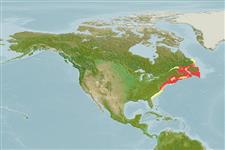Environment: milieu / climate zone / depth range / distribution range
Ecologia
marino demersale; oceanodromo (Ref. 51243); distribuzione batimetrica 5 - 143 m (Ref. 5951). Temperate; 55°N - 31°N, 82°W - 52°W
Western Atlantic: Labrador, Canada to Georgia, USA.
Length at first maturity / Size / Peso / Age
Maturity: Lm 26.8 range ? - ? cm
Max length : 64.0 cm TL maschio/sesso non determinato; (Ref. 7251); peso massimo pubblicato: 3.6 kg (Ref. 7251); Età massima riportata: 14 anni (Ref. 52686)
Adults inhabit soft muddy to moderately hard bottoms (Ref. 5951). Feed predominantly in daytime on organisms living in, on or near the bottom; shrimps, amphipods, crabs, sea urchins and snails (Ref. 12232). Batch spawner (Ref. 51846).
Vinnikov, K.A., R.C. Thomson and T.A. Munroe, 2018. Revised classification of the righteye flounders (Teleostei: Pleuronectidae) based on multilocus phylogeny with complete taxon sampling. Molecular phylogenetics and evolution, 125:147-162. (Ref. 122998)
IUCN Red List Status (Ref. 130435)
Threat to humans
Harmless
Human uses
Pesca: commerciale; Acquacoltura: sperimentale; Pesce da pesca sportiva: si
Strumenti
Special reports
Download XML
Fonti Internet
Estimates based on models
Preferred temperature (Ref.
123201): 0.7 - 13.1, mean 6.1 °C (based on 303 cells).
Phylogenetic diversity index (Ref.
82804): PD
50 = 0.5312 [Uniqueness, from 0.5 = low to 2.0 = high].
Bayesian length-weight: a=0.00832 (0.00493 - 0.01404), b=3.08 (2.94 - 3.22), in cm total length, based on LWR estimates for this species & (Sub)family-body (Ref.
93245).
Trophic level (Ref.
69278): 3.6 ±0.1 se; based on diet studies.
Generation time: 3.5 (2.6 - 4.2) years. Estimated as median ln(3)/K based on 20
growth studies.
Resilienza (Ref.
120179): Medio, tempo minimo di raddoppiamento della popolazione 1.4 - 4.4 anni (K=0.11-0.7(?); tm=2-3; tmax=10).
Prior r = 0.16, 95% CL = 0.10 - 0.23, Based on 3 full stock assessments.
Fishing Vulnerability (Ref.
59153): Low to moderate vulnerability (34 of 100).
Climate Vulnerability (Ref.
125649): High vulnerability (62 of 100).
Nutrients (Ref.
124155): Calcium = 35.4 [14.3, 62.0] mg/100g; Iron = 0.283 [0.138, 0.554] mg/100g; Protein = 17.4 [15.9, 18.8] %; Omega3 = 0.326 [0.159, 0.664] g/100g; Selenium = 17.6 [8.9, 39.0] μg/100g; VitaminA = 6.04 [1.44, 26.70] μg/100g; Zinc = 0.378 [0.252, 0.579] mg/100g (wet weight);
